brothy tomato pasta with white fish, sizzled shallots & capers
refreshing a "crazy" summer favorite
Today I’m revisiting one of my most popular recipes, one I developed for Food52 back in 2021 that fully embraces the delights of summer. I’d like to think people make this dish because it’s easy and delicious (it is), but it’s also possible it’s reeled people in for its unrepentant use of culinary it-words like “brothy” and “shallot” (this updated version is even more out-of-control with the addition of “sizzled”; I am not sorry). But the buzzy title is apt, not only because the recipe includes all of those things, but also because it is, in part, inspired by the queen of culinary buzzwords, Alison Roman, and her Tomato-Poached Fish with Chile Oil and Herbs. That dish, like this one, is made all the better thanks to a spicy shallot-garlic topping, and also includes a dash of fish sauce that imparts a lovely savoriness you can’t quite put your finger on but want to keep eating. Moreso, however, this recipe is inspired by one of my favorite Italian fish dishes: pesce all’acqua pazza, or “fish in crazy water.”
The origins of pesce all’acqua pazza are a bit murky. Some claim it was a preparation invented by the fishermen of Naples, which became especially popular in Capri in the 1960s; others suggest it comes from Ponza, the largest of the Pontine Islands of Lazio. Whatever the truth may be, the name seems to be a nod to the Italian tradition of cooking the day’s catch in seawater, giving it a uniquely salty taste. And although contemporary cooks no longer source their poaching liquid from the sea, the broth’s other ingredients remain the same: tomatoes, garlic, parsley, olive oil, and white wine are all you need. Typically, the fish of choice is seabream or seabass, both Mediterranean white fishes with a firm and flaky texture, and the meal might be accompanied by crusty bread to soak up the residual broth. I, of course, swapped one carb for another and opted for pasta—and not just any pasta, but stout calamarata rings that—you guessed it—mimic one of summer’s seafood staples, calamari. (The hollow tubes are great for catching tomatoes and flakes of fish; you can, of course, use whatever pasta you like.)
I generally shy away from including specialty ingredients in my recipes; it’s important to me that my dishes be accessible to all. That said, there is an (optional) item on today’s ingredient list that’s a little fancy and a little hard to find, but it’s a condiment that’s very near and dear to my heart: colatura di alici. Colatura is an aged Italian fish sauce made with just three ingredients: anchovies, salt, and time. It’s similar in concept to Southeast Asian fish sauce (the flavors are totally different, though both give you that umami punch), and a more direct relative of ancient Rome’s fermented fish sauce, garum. The name translates to “anchovy drippings” and, indeed, that’s how colatura is made—by layering anchovies and salt in wooden barrels, allowing them to ferment, and harvesting the liquid that results. Some say colatura’s flavor is stronger than other fish sauces, but I’m not so sure. To me, its briny, savory complexity is perfectly balanced, sea-like without being fishy. It’s sort of like high-quality balsamic vinegar: Deeply flavorful and best used sparingly, whether it’s in this dish, or with other pastas (like spaghetti con la colatura di alici), seafood, meats, vegetables, and vinaigrettes. I used this one here, but I really enjoy this one, too.
If you’ve made the original version of this recipe before, I hope you’ll try this revised iteration—I’ve tweaked some of the instructions and quantities and think the balance is better. I have also spotted recent changes to the original recipe that were made without my prior knowledge or consent, and I cannot attest to the quality in its current state. But I can attest to how yummy this one is—perfect for your summer tomatoes and dining al fresco.
Brothy Tomato Pasta with White Fish, Sizzled Shallots & Capers
Serves 2 to 4
For the topping
¼ cup (60 ml) extra-virgin olive oil
4 garlic cloves, thinly sliced
1 large or 2 small shallots, peeled and thinly sliced into rings
1 heaping tablespoon (20 grams) capers in brine, drained, patted dry, and roughly chopped
1 tablespoon roughly chopped flat-leaf parsley, plus more for serving
A generous pinch crushed red pepper flakes
For the pasta & broth
2 tablespoons (30 ml) extra-virgin olive oil, plus more for serving
1 pound (about 2 cups; 450 grams) cherry tomatoes, halved
Kosher salt & freshly ground black pepper
1 tablespoon (15 grams) tomato paste
½ cup (120 ml) dry white wine like Pinot Grigio
2 cups (500 ml) water
1 to 2 teaspoons (5 to 10 ml) colatura di alici or fish sauce (optional; see headnotes)
8 ounces (225 grams) calamarata, mezzi paccheri, mezzi rigatoni, or other tubular pasta (I used this one)
1 pound (450 grams) boneless and skinless mild, flaky white fish like halibut, sea bass (not Chilean), sea bream, grouper, or cod, patted dry and cut into 2-inch pieces (I used halibut)
Lemon wedges, for serving
For the topping
In a small saucepan, warm the oil over medium heat. Add the shallots and garlic and cook, stirring frequently, until they just begin to brown, about 5 minutes (watch carefully!).
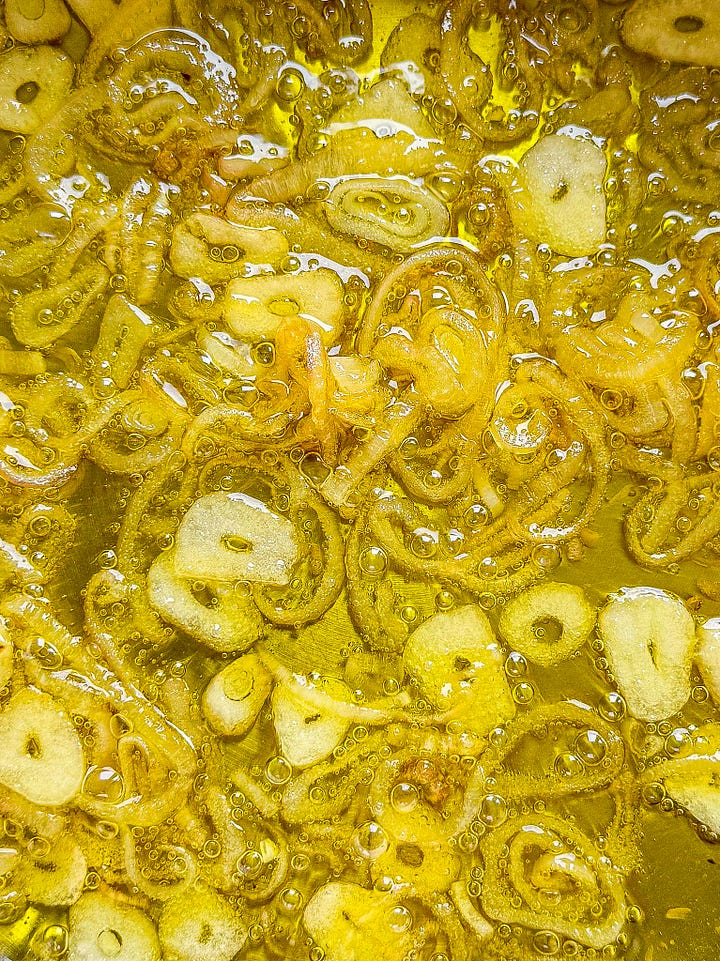
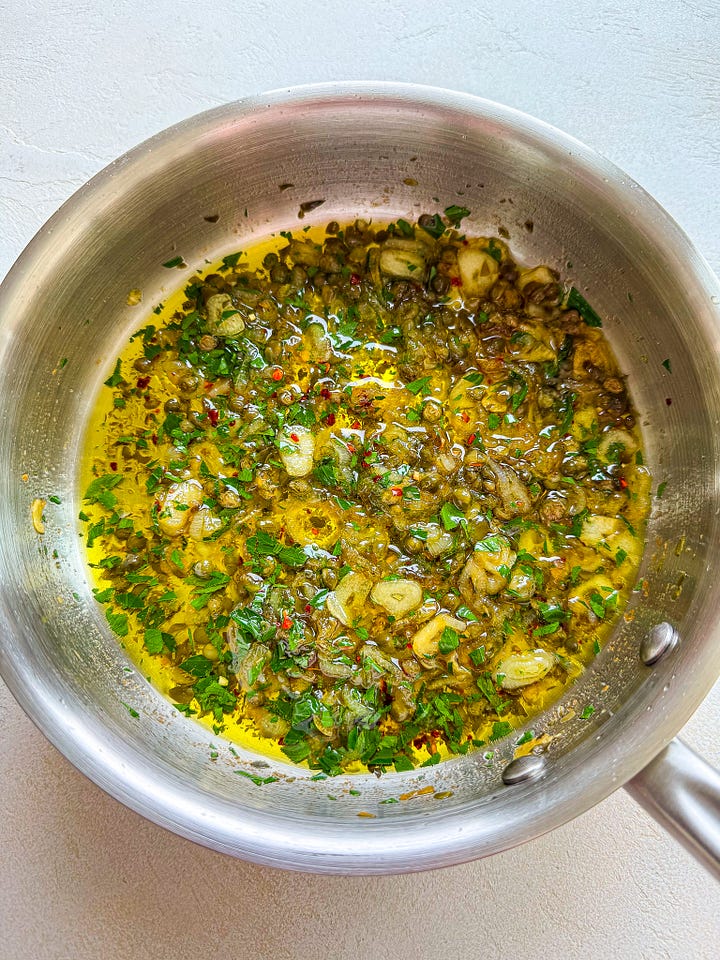
Add the capers and cook, stirring, 1 minute more. Turn off the heat and stir in the red pepper flakes and parsley. Transfer to a bowl and set aside.
For the pasta & broth
Start bringing a large pot of water to a boil.
In a Dutch oven or sauté pan with a lid, warm the oil over medium heat. Add the tomatoes, season generously with salt and pepper, and cook, stirring occasionally, until soft and jammy, 8 to 10 minutes.
Stir in the tomato paste and cook 1 minute more. Follow with the wine, scraping up any bits from the bottom of the pan, and cook for 2 to 3 minutes. Add the water and simmer, stirring occasionally, until slightly reduced, 10 minutes. Stir in the colatura or fish sauce (if using) and adjust seasoning to taste.
When the broth is almost done simmering and the water is boiling, season it generously with salt. Add the pasta, stir for a few moments to prevent sticking, and cook, stirring occasionally, according to the package directions until just shy of al dente or your liking.
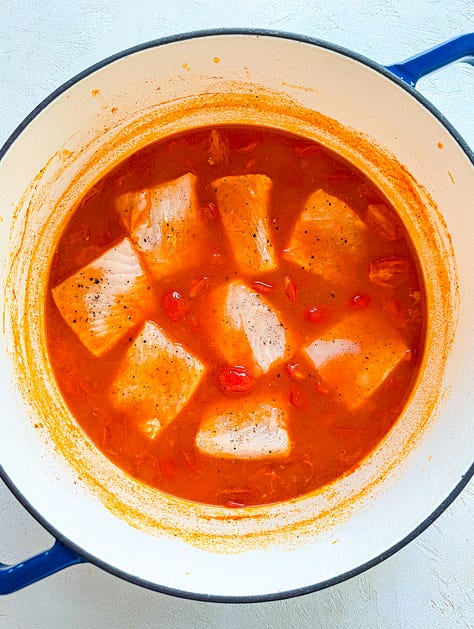
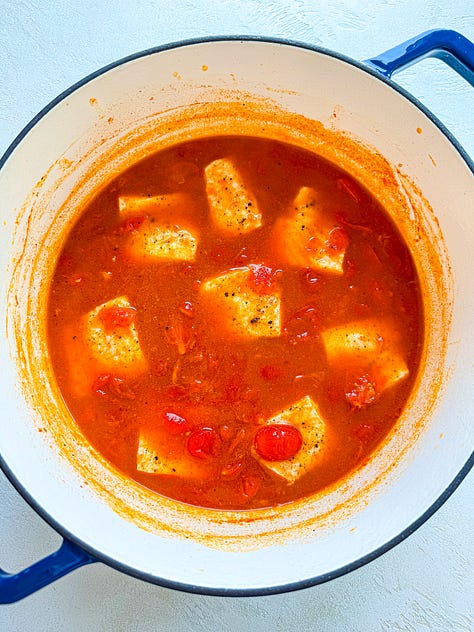
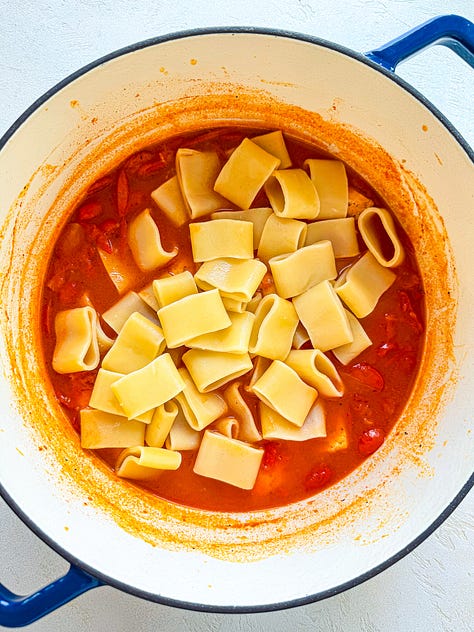
While the pasta cooks, generously season the fish with salt and pepper. Add the fish to the broth, cover the pot, and cook over low heat for 2 minutes. Gently flip the fish, cover once more, and cook an additional 2 minutes, or until just cooked through (it should start to flake when pulled at with a fork).
With a spider sieve or slotted spoon, transfer the pasta directly to the broth (or, if preferred, drain the pasta in a colander, then immediately tip it into the broth). Stir gently to coat, breaking up the fish into large flakes as you do so. Cook over medium-low heat for another minute so the pasta can absorb the flavors of the broth.
Divide the pasta, fish, and broth among bowls. Spoon over some of the caper topping, sprinkle with more chopped parsley, and finish with a generous drizzle of good olive oil. Serve with lemon wedges for squeezing over the top.
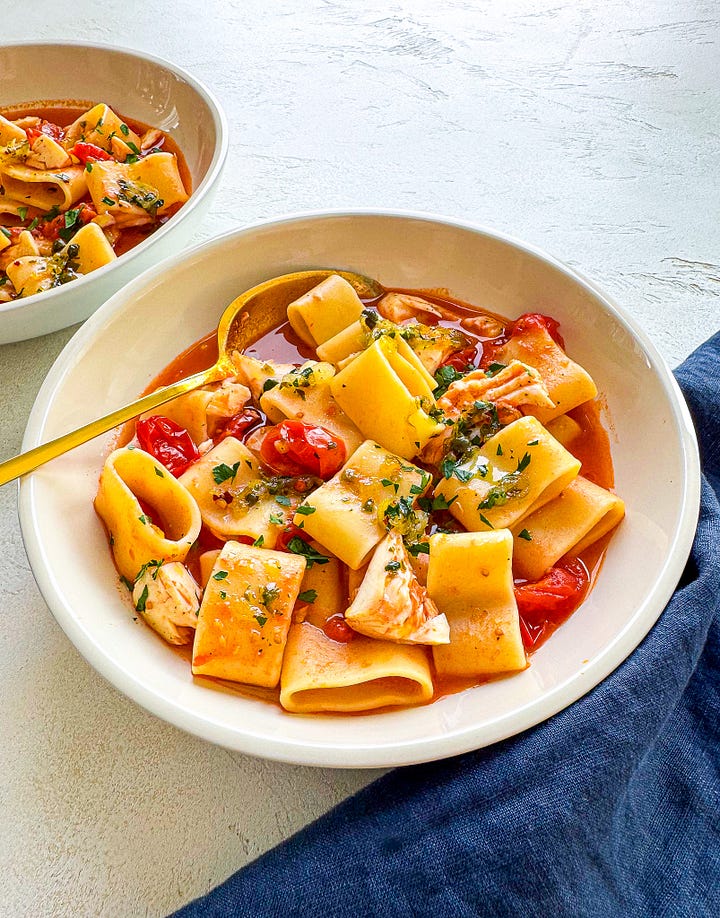
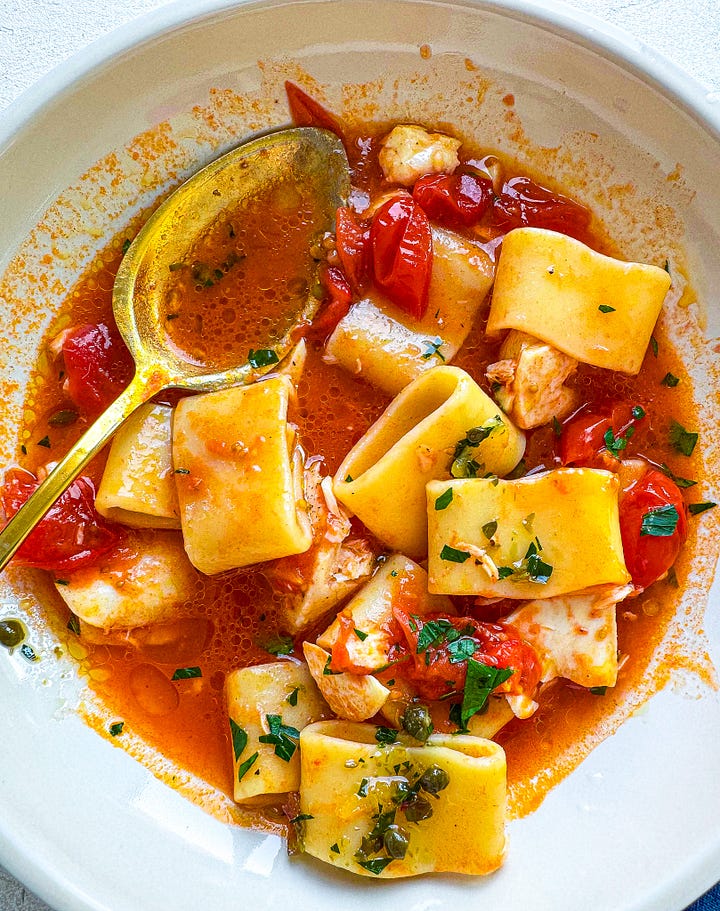

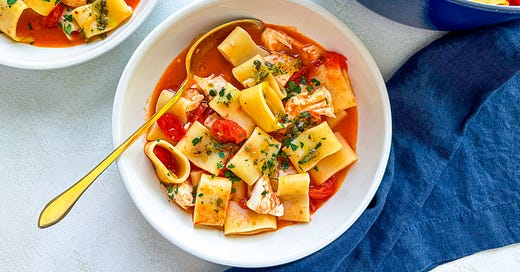



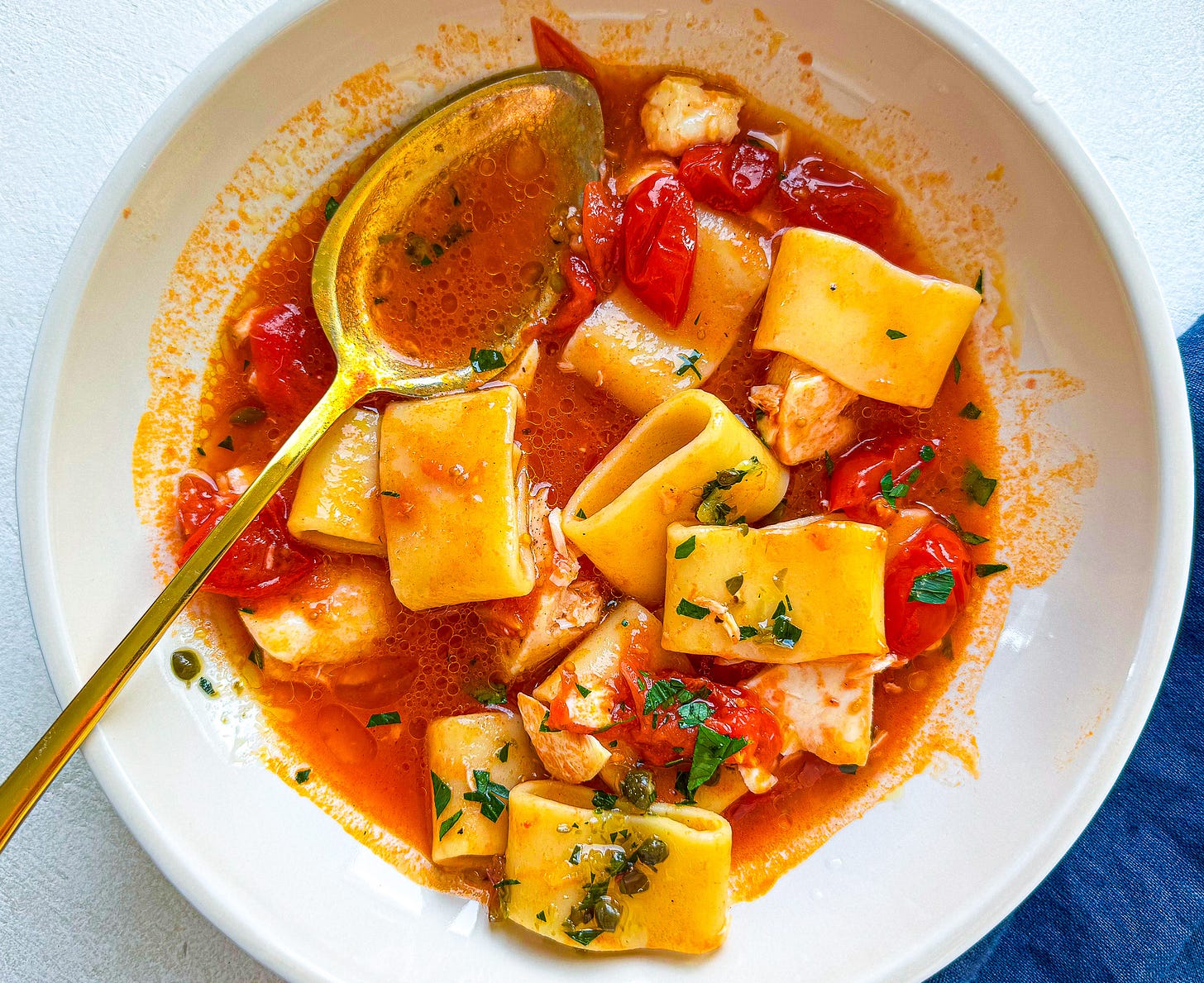


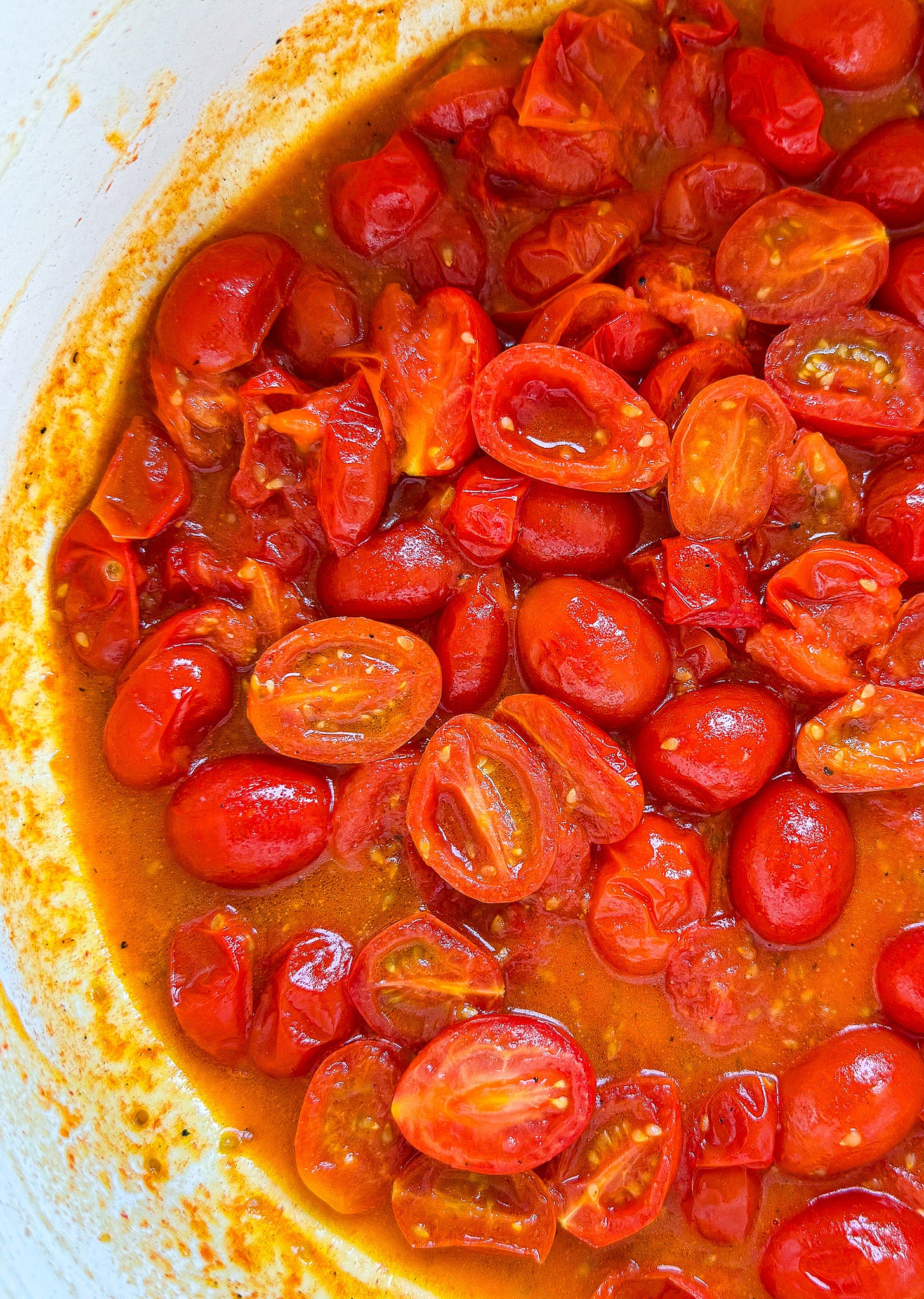
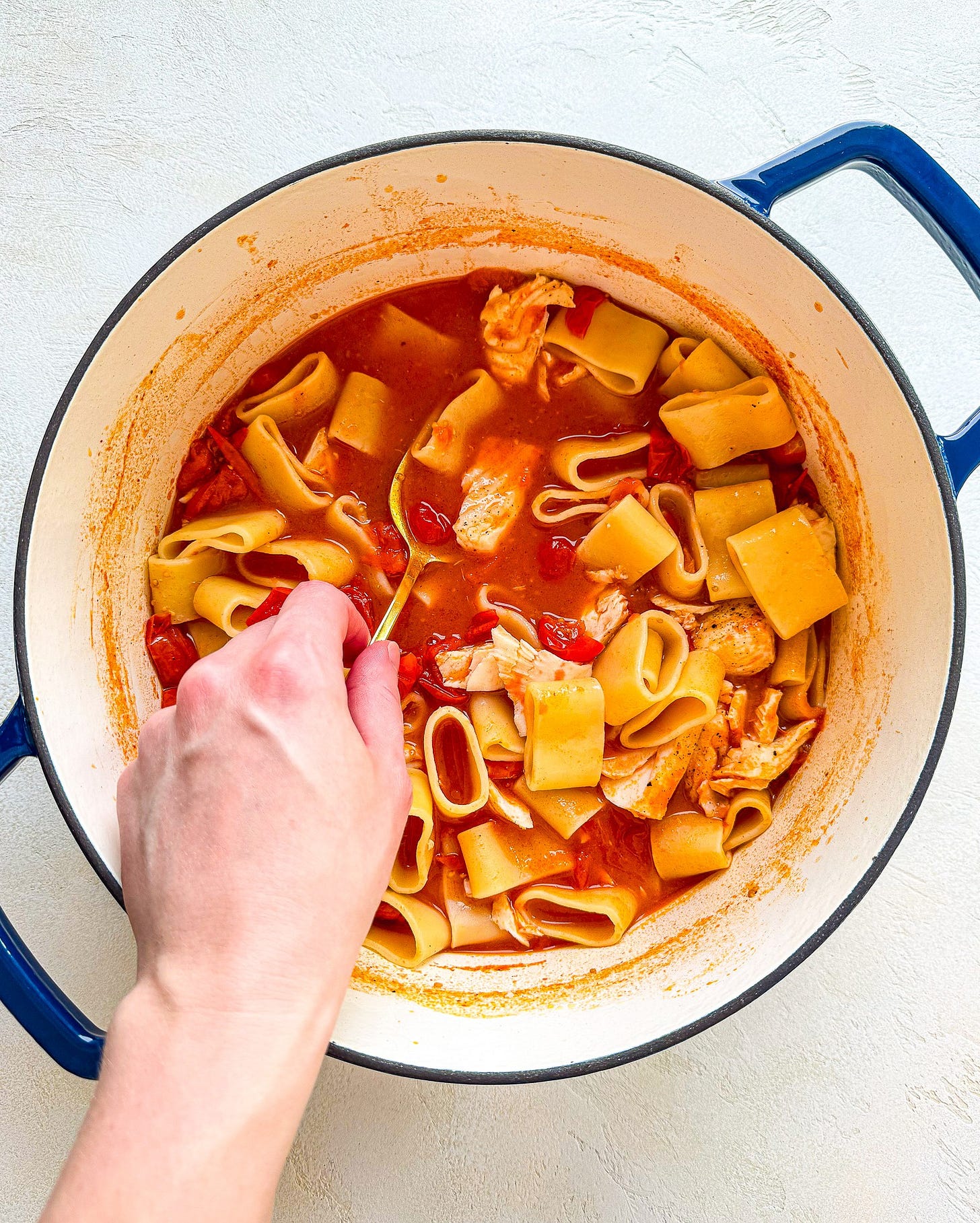


This is my new favorite summertime recipe for fish and shellfish. The addition of the colatura transforms the flavors of this sauce. I know that I will make this recipe over and over and over... Wow is this good! Thanks for sharing your secret weapon with us all, Colatura di Alici.
I am fortunate to live near Sacramento, California, and Corti Brothers. The store carries organic calamaretti pasta by Gentile, Pasta di Gragnano, made with durum wheat semolina in Italy.
This sounds so good! I actually always have frozen halibut fillets in the freezer and I think this would be perfect.